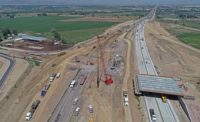In 2018, the Utah Legislature not only handed the Utah Dept. of Transportation a record $1.7-billion budget, it also tasked the agency with looking a little further down the road, so to speak.
“The Legislature felt we had grown into a much larger organization, and there were a lot of things happening as far as autonomous vehicles and artificial intelligence and growth, so they broadened the scope of the department significantly,” says Carlos Braceras, UDOT executive director.
That expansion included UDOT taking responsibility for enhanced statewide planning, working more closely with regional governments and developing capital transit projects, including rail, bus rapid transit (BRT) and other transit initiatives. “We want to do a better job integrating with communities on understanding the impacts of their land-use decisions and our ability as a state department of transportation to help meet the needs of those communities,” Braceras says.
UDOT currently has 84 projects underway, and for fiscal year 2020, the agency will manage a budget of $1.8 billion. Last year, to fulfill directives from the Legislature, UDOT promoted two employees, Teri Newell and Jason Davis, to fill new deputy director positions. Newell manages planning and investment and Davis leads engineering and operations.
While those executive changes were underway, the agency continued to move forward with major projects. The largest is the $450-million reconfiguration and improvement of freeway and state highway interchanges at the north end of Utah County, known as the Technology Corridor. The progressive design-build contract includes new overpasses, road realignments and widening. It is being completed by a joint venture of Ames Construction and Wadsworth Brothers Construction.
Also under construction is the $136-million widening of Interstate 15 in Salt Lake County, led by Draper, Utah-based Ralph L. Wadsworth Construction. The project adds a new southbound lane from 2100 South to 12300 South and redesigns the southbound ramps at the I-15/Interstate 215 south interchange to improve traffic flow.
This summer, crews will finish a reconstruction of I-215 from the I-15 interchange in North Salt Lake to 2200 North. Sundt Construction’s work on the $25-million project is focused this spring on completing a new diverging diamond interchange (DDI) at Redwood Road and I-215.
A new project ramping up this year will be the $158-million addition of nearly 12 miles of express lanes on northbound I-15 between the cities of Layton and Riverdale.
Rolling Out New Tech
In his new position as deputy director of engineering and operations, Davis has been overseeing implementation and testing of new technologies for the agency.
Last year the agency piloted a Dedicated Short-Range Communications (DSRC) and Multi-Modal Intelligent Traffic Signal System. It allows buses and other public vehicles to communicate with traffic signals in real time to keep traffic running as smoothly as possible on major arterials.
Working with the Utah Transit Authority, UDOT installed the system on a bus route along Redwood Road. The DSRC system was installed on signals at 24 intersections along 11 miles of the major north-south route.
“The [Utah] Legislature ... broadened the scope of the department significantly.”
– Carlos Braceras, Executive Director, UDOT
“The bus talks with the signals and the signals talk with the bus,” Davis says. “The system knows where the bus is—if it’s on schedule, how many people are on the bus—and it can make decisions to adjust signals to keep it on schedule. We’ve seen a remarkable increase in reliability on the route, starting in the low 80% of on-time arrival up to the low 90%.”
The system has since been expanded to the two BRT vehicles operating in Provo and was tested on several snowplows this winter. “If we can give our snowplows signal preemption, we can get the roads cleared quicker, and that makes it safer for everyone,” Davis says. “We are going to evaluate what we saw from the tests we did at the end of this winter, and it may be something we expand to our fleet.”
Another innovation that will soon make its public debut is a self-driving shuttle.
“We want to be involved with this technology because we think it’s the next step in getting us closer to our goal of zero fatalities on the roads,” Davis says. “When seatbelts were introduced, they increased safety, and the same with airbags and antilock brakes. Ninety-four percent of accidents are human caused, but we want to get people used to the idea of not having a person driving the vehicle.”
In its recent session, the state Legislature adopted a measure to address the liability and legality of driverless vehicles. Partnering with a company called Easy Mile, UDOT driverless shuttles will be deployed in contained areas like shopping mall parking lots and university and state agency campuses, Davis says.
“It is really not very exciting when you first use it because it’s slow,” says Braceras. “But we don’t really want it to be exciting. We want people to see the capability and get used to it and see where we’re going.”
No More Easy Stuff
Planning leader Newell and her team will be focused on statewide efforts as Utah’s cities burgeon with new residents and bedroom communities or semi-rural towns feel the pressure on their roads.
“When we are faced with so much growth, we really need everybody to be focusing on how we are going to deal with it,” Newell says. “We have run out of easy solutions. The things we are facing in the next 30 years are going to take everybody working together and some real forward thinking to maintain quality of life.” Newell says a “stakeholder” committee was assembled within the past year that includes the Governor’s Office of Economic Development, Bike Utah, metro planning organizations, UTA and others to create a long-term vision for the state and the role of transportation.
“We are not sure what will come out of this process at this point, but in the end it will influence our project prioritization process,” Newell says. “The last time we made updates to our prioritization process was 15 years ago, and we know it is time to update it. We want to know what comes out of this visioning process so we can match up projects with statewide goals in mind.”
A division within Newell’s department also will include a technology and innovation group that gathers and analyzes data collected by the agency. “We collect a lot of data,” says Braceras. “When we lay all that data on top of each other, we think we will be able to ask better questions and get better answers.”
Newell says bringing the collected data together within one group will allow it to be more useful. Among the new projects is a program to charge electric and alternative-fuel vehicles a fee for miles driven as a way to address the problem of lower tax revenue as many vehicles operate outside the reach of gasoline taxes and as fuel efficiency increases.
“We are looking at a voluntary [reporting] program that will begin in 2020,” Newell says. “We know this is the direction things are going, and we want to have a different collection mechanism in place in the future.”







